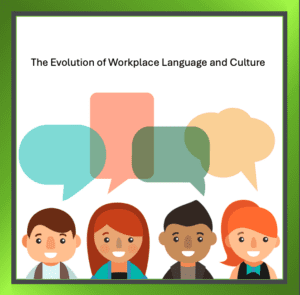Five Years of Change: Evolving Workplace Language and Culture
Five years after Britain’s first Covid-19 lockdown, it’s remarkable to consider how this period has not only transformed where we work but also the language, we use to describe our professional lives.
The changes in workplace vocabulary reflect broader shifts in work culture, from the adoption of hybrid models to a strong emphasis on authenticity and wellbeing.
One of the most notable transitions in workplace communication has been the rise in virtual interactions. The average number of meetings per person increased by 12.9%, while their duration decreased by 20.1%, highlighting the need for more concise and efficient communication.
Employees quickly developed new expressions to navigate this changed landscape. Abbreviations like ‘WFH’ working from home and ‘EOD’ end of day illustrate how professional communication adapted to a faster and more intense digital work environment. Meanwhile, ‘OOO’ out of office gained new significance as flexible schedules blurred traditional work hours.
This trend mirrors a common human tendency to simplify language under pressure, reflecting a broader societal shift towards efficiency and clarity. Since the Covid-19 pandemic, there has been a significant change in attitudes towards work performance, with productivity increasingly measured by output rather than time spent at a desk.
Digital Transformation and Hybrid Work Culture
As companies adapted, workplace communication evolved in response to new working methods. By 2023, 83% of companies had implemented hybrid work models, leading to a new wave of workplace jargon. Terms like Zoom fatigue, describing the exhaustion of consecutive video calls, became part of everyday language, sparking discussions about the challenges of remote work.
Similarly, ‘bandwidth’, once an IT term, was repurposed to describe personal capacity, while ‘asynchronous working’ became key in flexible work arrangements, highlighting a growing acceptance that productivity doesn’t need to occur within a strict nine-to-five schedule. These linguistic changes signified deeper cultural shifts, reinforcing expectations of autonomy and adaptability in the workplace.
The Vocabulary of Workplace Values
The increasing presence of Gen Z employees has significantly influenced workplace language. Their push for openness has reshaped professional communication, leading to the adoption of terms like ‘wellness-first culture’ and ‘overemployment’, which encourage discussions around work/life balance and mental health.
The rise and fall of certain buzzwords also reflect shifting employee priorities. ‘Quiet quitting’ gained popularity with a 218% increase in Google searches in 2022 but was soon criticised for portraying healthy boundaries as disengagement.
Similarly, phrases like ‘the new normal’ and ‘unprecedented times’ became widely used before quickly falling out of favour, as they began to feel more like clichés than meaningful expressions.
Crucially, these changes have impacted work-life balance. During lockdown, 78% of remote workers reported an improved work/life balance, and 33% of employers observed increased productivity among hybrid employees. This evolving dynamic has led to a shift from ‘work/life balance’ to ‘work/life integration’ and now ‘work-life harmony’, reflecting a desire to blend personal and professional life in a more natural and sustainable way.
For example, phrases like ‘logging off to recharge’ or ‘taking a mental health day’ indicate that today’s workforce values productivity alongside wellbeing.
Power Dynamics and the Future of Work
Linguistic shifts not only reflect but also influence changes in workplace power dynamics. The Great Resignation introduced terms like ‘boomerang employees’ those who leave and return and ‘quiet hiring’ redeploying internal talent instead of recruiting externally.
These phrases suggest a more fluid and employee-driven job market, where workers have greater control over their careers.
Ultimately, the words we use to describe work do more than reflect change; they actively shape it. The evolving workplace lexicon is a testament to a workforce that increasingly prioritises flexibility, wellbeing, and authenticity over outdated corporate norms.
Five years on from the first lockdown, it is evident that these linguistic shifts are not fleeting trends but rather enduring indicators of a fundamental transformation in how we work and communicate.
Stats – Hrmagizine

